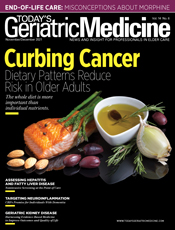
November/December 2021
Technology: Closing Care Gaps Chronic disease management and effective care for older adults rely on improved quality and risk adjustment scores. Approximately 49 million Americans are 65 and older, with projections estimating that the population of older adults will grow to 98 million in 2060. Older adults are disproportionally affected by chronic conditions such as diabetes, arthritis, and heart disease. Eighty percent have at least one chronic condition, and nearly 70% of Medicare beneficiaries have two or more. Medicare Advantage (MA) enrollment has grown rapidly over the past decade. In 2020, 39% of all Medicare beneficiaries—24 million people out of 62 million Medicare beneficiaries overall—were enrolled in MA plans. The Congressional Budget Office projects that the share of all Medicare beneficiaries enrolled in MA plans will rise to about 51% by 2030. Chronic diseases often limit a person’s ability to perform daily activities, thwart their independence, and lead to institutional care, in-home caregivers, or other long-term services. Multiple chronic diseases account for two-thirds of all health care costs and 93% of Medicare spending. But less than 1% of US health care dollars goes toward prevention to improve overall health. As more elder care organization’s shift toward greater clinical capabilities and integration across the care continuum, they are choosing to partner with primary care networks, physician-led accountable care organizations (ACO), and Medicare Advantage networks. Participating in value-based care could drive better outcomes and quality of life for individuals and their families. This shift is happening just as the Centers for Medicare & Medicaid Services (CMS) ramped up its promotion of value-based programs to reduce overall costs and improve quality care for Medicare beneficiaries. Because CMS uses MA’s risk adjustment model, known as the CMS-Hierarchical Chronic Categories (HCCs) Risk Adjustment model, to determine payments for MA plans, geriatricians should consider the benefits of partnering with a risk adjustment expert to improve patient outcomes. How Risk Adjustment Works Lower than anticipated risk scores would have an impact on payments for MA plans due in part to how CMS calculates payment plans. This also means that plans would not receive payments equivalent to their expected costs in the upcoming year and deferred care from 2020 could lead to higher health care costs for plans in 2021. In this environment, MA plans should look for strategies to effectively enable providers to identify open care gaps for proactive gap closure and provide payer-agnostic data to inform clinical, quality, and risk adjustment programs for improvements in quality, risk adjustment scores, and patient outcomes. Key Factors Risk Adjustment Factors Because RAF scores are reset every year, health care providers must reassess patients’ diagnoses and chronic conditions every year, making the collection and reporting of accurate and comprehensive diagnoses of paramount importance. Correctly identifying active diagnosis assists in the treatment of patients throughout the system and ensures that adequate resources are available. HCCs are assigned a value that, when all of a member’s HCCs are summed, create the RAF score. Recapture HCCs Social Determinants of Health Integrating these data enables providers to optimize relationships with community-based organizations and better understand the impact of SDOH on quality ratings. Furthermore, payers can better understand potential insurance risk and optimize member engagement. Understanding how SDOH affect care is critical for identifying gaps in care and addressing barriers with appropriate interventions. Capturing these data through claims makes it possible to close those gaps in care, accurately recapture HCCs, improve utilization management, and ensure proper reimbursement. Improving Risk Adjustment Accuracy for Financial Impact Geriatricians should consider adopting a value-based care enablement solution that captures data from disparate sources, allowing 360-degree visibility into the patient’s health status. These real-time insights align the payer, provider, and patient with one solution that proactively closes care gaps to ensure a complete health status for improvements in care delivery and health outcomes. The solution should also offer an analytics engine that prioritizes high-risk patients with suspected conditions and provides the financial impacts of those suspected conditions. These intelligent analytics can break down patient population through data visualization tools and reporting and be pushed directly to the provider at the point of care. The most effective solutions generate suspect lists to manage retrospective, concurrent, and prospective clinical programs. They also support in-home evaluation results and impact reporting and RAF score prediction. It’s also important to find a solution that uses connectivity with EHRs and bidirectional data feeds between disparate systems to extract continuity of care data, allowing the provider to receive real-time data insights at the point of care. Ultimately, the value-based care enablement solution will reduce administrative burden, may be used across the organization, and can eliminate the use of multiple platforms. Look for a solution that offers at least 85% provider engagement rate and effectively improves workflows, documentation, collaboration, and patient outcomes, driving risk adjustment score accuracy. With an accurate risk score, reimbursement can match the total cost of necessary care, ensuring adequate funding to improve quality of life for patients and pave the way for financial sustainability for organizations and providers focusing on care for elderly populations. — Josh Hetler is executive vice president of business intelligence at DataLink. |
